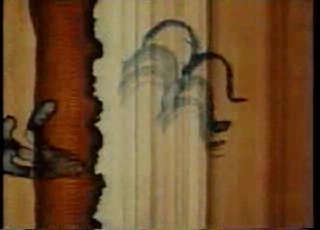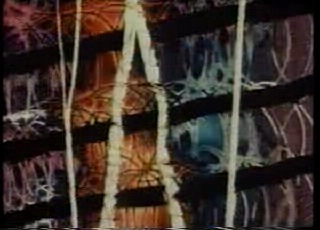
Miles Davis (right) with bebop innovator Charlie Parker (left).
I read on Cartoon Brew today that a “debate” of sorts has erupted online about the artistic merits of the animation studio UPA and the studio’s contribution to the art form. Jerry Beck pointed to Michael Sporn’s blog, where many of the comments there reveal a misunderstanding of innovation and tradition in the arts in general. In particular, I was amused by a comment by animation “theorist” Eddie Fitzgerald:
“I blame bebop which exerted a bad influence even on graphic art on and which wasn’t nearly as good as the swing music that preceded it. Early bop was funny but it quickly morphed into something arid and bleak, good music to accompany suicide. For some reason intellectuals latched on to it, maybe because they didn’t dance much.
I’m not here to argue for the validity of bebop, that battle was fought and won 50 years ago. I wish to address Fitzgerald’s value judgement, that “[bebop] wasn’t nearly as good as the swing music that preceded it.” Bebop introduced to jazz a new set of aesthetic goals. If you look to bebop to accomplish the exact same goals as swing music, of course you’re going to be disappointed. But bebop was not born in a vacuum, it borrowed key components of swing music (rhythmic feel, popular song structures, improvisation) and introduced a new harmonic vocabulary. Conceptually, this is not different from what the artists at UPA were doing.
Blaming bebop for the development of graphic art trends in the 40s and 50s is also historically inaccurate. If we’re going to “blame” a movement, it would have to be modern art in general. UPA is widely recognized as the first Hollywood studio to fully integrate modern art aesthetics into its commercial output. In Art in Motion, Maureen Furniss writes, “UPA aligned itself with everything modern – in its art style, in its adaptation of contemporary literature, and its progressive social views.” It was only natural that UPA would also align itself with modern music.

Just as the designers at UPA sought to develop a new visual language, a new musical language was just hitting the west coast. Charlie Parker and Dizzy Gillespie gave their first west coast performance in December 1945 at Billy Berg’s Vine Street Club, exposing a whole new audience to the language of be-bop. UPA’s animation shared many conceptual similarities with be-bop. Commenting on Hubley’s character design, Michael Barrier writes in Hollywood Cartoons, “It is ideas alone that are being expressed, and the characters exist only as vehicles for these ideas.” Similarly in be-bop, a song exists chiefly as a vehicle for the expression of the improviser’s musical ideas.
Left: Hubley character studies from “Rooty Toot Toot,” posted at the Cartoon Modern blog.
A number of UPA’s cartoons feature modern jazz in their soundtracks. Hotsy Footsy (1952) and A Wounded Bird (1956) both featuring the music of Shorty Rogers. Chico Hamilton wrote and performed UPA’s theme music. Rather hiring a staff composer, a model established by MGM and Warner Bros., UPA assigned each cartoon to a freelance musician. Hollywood arranger Phil Moore contributed jazz scores to Hubley’s Oscar-nominated Rooty Toot Toot (1952) and a Tang television commercial produced in 1959. I cannot claim to know every instance of jazz in UPA’s library of shorts. A complete inventory of the use of jazz in UPA’s cartoons is virtually impossible, as so few of UPA’s shorts have been released on home video.

Any perception of the UPA design aesthetic as inherently “jazzy” may also be due to the influx of music industry designers who found work in animation during the 50s. Jim Flora’s wildly modernist album artwork for Columbia records in the early forties created a “look” for jazz music in a time where film and television footage of jazz musicians was far and in-between. Flora freelanced as a storyboard artist for UPA’s commercial unit in New York City.

Artist Gene Deitch was also invited to work at UPA based on his jazz-related artwork. The UPA heads saw Deitch’s art in an obscure jazz magazine called The Record Changer. He got a call from the studio, and at age 22 he began an apprenticeship under John Hubley and Bill Hurtz, who had joined UPA as a designer. At the time, Deitch held extremely conservative musical views, and The Record Changer‘s main demographic was traditional “trad” jazz fans. Clearly the UPA leadership, who were reading the magazine, also held respect for the past in the jazz tradition.
The left-leaning artists at UPA were likely attracted to bebop’s socially progressive identity. Many of UPA’s artists were members of or had associated themselves with the Communist Party USA, to the extent that Walt Disney referred to UPA as “the commies down the river.” The Hollywood labor force was undergoing a tumultuous decade, and UPA’s artists may have found inspiration in the African-American expression of freedom in bebop.
So did bebop “cause” the artistic developments at UPA? Of course not. Overtime, UPA has become somewhat synonymous with bebop. I would like to point out that the only founding bebopper who had any kind of professional relationship with a UPA artist was Dizzy Gillespie, and his collaboration with John Hubley occurred after Hubley had left UPA and founded his own production company.
And as for the suggestion that bebop is “arid and bleak,” check out Charlie Parker’s concert at Massey Hall and tell me if it isn’t some of the most joyful music you’ve ever heard.



 Posted by jazzanimated
Posted by jazzanimated 



















 Valarie T. Richard’s out-of-print book Norman McLaren, Manipulator of Movement contains a fascinating account of how Begone Dull Care was made. The film is truely a collaboration between artist and musician. From Richard’s book:
Valarie T. Richard’s out-of-print book Norman McLaren, Manipulator of Movement contains a fascinating account of how Begone Dull Care was made. The film is truely a collaboration between artist and musician. From Richard’s book:
